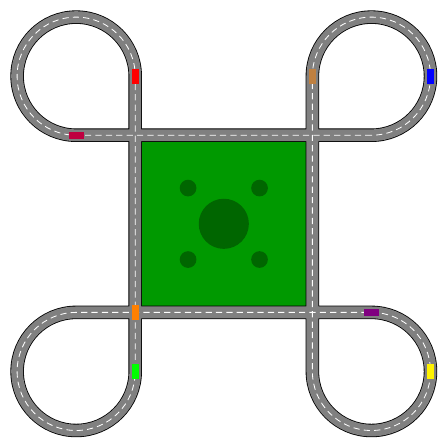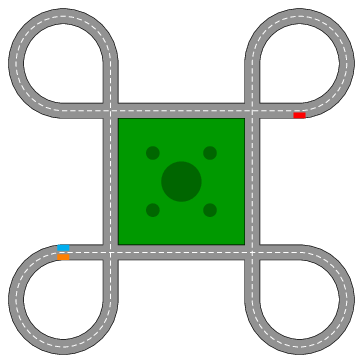
考虑以下 MWE:
\documentclass[border=5pt,tikz]{standalone}
\usetikzlibrary{calc}
\tikzset{
car/.style={
scale=.5,minimum width=.1cm,minimum height=.5cm,fill=#1
}
}
\begin{document}
\foreach \n in {0,10,...,360,350,340,...,0}
{
\begin{tikzpicture}
\fill[green!60!black] ([xshift=1mm,yshift=-1mm]1,0) rectangle ([xshift=-1mm,yshift=1mm]4,-3);
\path ([xshift=1mm,yshift=-1mm]1,0) -- ([xshift=-1mm,yshift=1mm]4,-3) node[midway,fill=green!40!black,circle,inner sep=.3cm] (a) {};
\node[fill=green!40!black,circle,inner sep=.1cm,above left=.5cm] at (a) {};
\node[fill=green!40!black,circle,inner sep=.1cm,above right=.5cm] at (a) {};
\node[fill=green!40!black,circle,inner sep=.1cm,below left=.5cm] at (a) {};
\node[fill=green!40!black,circle,inner sep=.1cm,below right=.5cm] at (a) {};
\draw[double distance=2mm,double=gray] (5,0) -- (0,0) arc(-90:-360:1) --+ (0,-5) arc(0:-270:1) --+ (5,0) arc(90:-180:1) --+ (0,5) arc(180:-90:1);
\draw[white,densely dashed] (5,0) -- (0,0) arc(-90:-360:1) --+ (0,-5) arc(0:-270:1) --+ (5,0) arc(90:-180:1) --+ (0,5) arc(180:-90:1);
\node[shift={(0,1)},car=red,rotate=\n] at (\n:1) {};
\node[shift={(5,1)},car=blue,rotate=-\n] at (-\n:1) {};
\node[shift={(0,-4)},car=green,rotate=-\n] at (-\n:1) {};
\node[shift={(5,-4)},car=yellow,rotate=\n] at (\n:1) {};
\pgfmathsetmacro\factor{\n/360}
\node[rotate=-90,car=purple] at ($(0,0)!\factor!(5,0)$) {};
\node[rotate=-90,car=violet] at ($(5,-3)!\factor!(0,-3)$) {};
\node[car=brown] at ($(4,1)!\factor!(4,-4)$) {};
\node[car=orange] at ($(1,-3)!\factor!(1,0)$) {};
\end{tikzpicture}
}
\end{document}
输出如下:
我的问题是:我怎样才能让车子沿着轨道的“弧线部分”移动?我本来可以用\ifnum,但我觉得太费力了……
答案1
只是为了好玩:一种将汽车置于道路任意位置的简单方法。为了让@DavidCarlisle高兴,汽车在道路的错误一侧行驶。
\documentclass[border=5pt,tikz]{standalone}
\usetikzlibrary{calc,decorations.markings}
\tikzset{
car/.style={
scale=.5,minimum width=.1cm,minimum height=.5cm,fill=#1
},
car on road/.style args={at pos #1 with dist #2 and color #3}{decorate,decoration={markings,
mark=at position #1 with {\path (-2pt,#2) coordinate (aux1)
(2pt,#2) coordinate (aux2);
\pgftransformreset
\path let \p1=($(aux2)-(aux1)$),\n1={90+atan2(\y1,\x1)} in
($(aux2)!0.5!(aux1)$) node[car=#3,rotate=\n1]{};}}}
}
\begin{document}
\def\roadpath{(5,0) -- (0,0) arc(-90:-360:1) --+ (0,-5) arc(0:-270:1) --+ (5,0) arc(90:-180:1) --+ (0,5) arc(180:-90:1)}
\foreach \n in {0,5,...,355}
{
\begin{tikzpicture}
\fill[green!60!black] ([xshift=1mm,yshift=-1mm]1,0) rectangle ([xshift=-1mm,yshift=1mm]4,-3);
\path ([xshift=1mm,yshift=-1mm]1,0) -- ([xshift=-1mm,yshift=1mm]4,-3) node[midway,fill=green!40!black,circle,inner sep=.3cm] (a) {};
\node[fill=green!40!black,circle,inner sep=.1cm,above left=.5cm] at (a) {};
\node[fill=green!40!black,circle,inner sep=.1cm,above right=.5cm] at (a) {};
\node[fill=green!40!black,circle,inner sep=.1cm,below left=.5cm] at (a) {};
\node[fill=green!40!black,circle,inner sep=.1cm,below right=.5cm] at (a) {};
\draw[double distance=3mm,double=gray] \roadpath;
\draw[white,densely dashed] \roadpath;
\pgfmathsetmacro\factor{\n/360}
\path[car on road=at pos {\factor} with dist 1mm and color red] \roadpath;
\path[car on road=at pos {1-\factor} with dist -1mm and color blue] \roadpath;
\pgfmathsetmacro\factor{mod(\n/360+0.5,1)}
\path[car on road=at pos {\factor} with dist 1mm and color cyan] \roadpath;
\path[car on road=at pos {1-\factor} with dist -1mm and color orange] \roadpath;
\end{tikzpicture}
}
\end{document}




